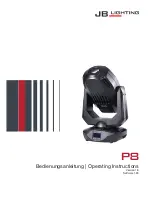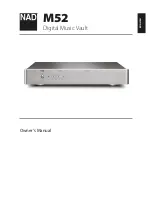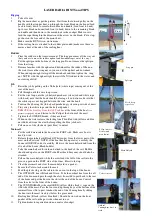
5115 Hadley Ave. N., St. Paul, MN 55128 (USA) www.parktool.com
PARK TOOL CO.
TS-8 Home Mechanic Wheel Truing Stand
Designed specifically for the home mechanic, the TS-8 Truing Stand allows accu-
rate, reliable truing of 16” to 29” wheels. The TS-8 can be used freestanding or bolt-
ed to a bench for extra stability.
ASSEMBLY
Tools Required: 5mm hex wrench, 11mm open end wrench, straight-blade screwdriver.
1. Attach base (#7) to left upright (#1) and right upright (#4) with carriage bolts
(#8), washers (#6), and nylok nuts (#5).
2. Attach gauge holder (#14) to left upright with gauge holder screw (#12), coil
spring (#13), washer (#6), and nylok nut (#5).
3. Attach spacer (#10) and gauge (#9) to gauge holder (#14) with knob and shaft (#11).
4. Place sliding dropout (#2) into right upright. Thread ball plunger (#3) into threads
of right upright and tighten, allowing dropout to move smoothly.
SET-UP
1. Inspect rim for cracks, bulges, dents and flat spots. Check for broken or loose
spokes, and for nipples that may be rounded or rusted. Make sure hub is adjust-
ed properly and axle is not bent. Repair or replace parts as needed.
2. Lubricate each nipple. Clean excess lubricant from rim.
3. Use a spoke wrench properly sized to fit the wheel’s spoke nipples. Park Tool
Professional Quality Spoke Wrenches are recommended.
LATERAL TRUING BASICS: CORRECTING SIDE TO SIDE ERRORS
1. Remove tire (if desired) and place wheel into “V” notches of TS-8. To insure ac-
curate results, wheel must be locked in TS-8 using wheel’s quick release or
axle nuts.
2. Position tip of gauge to sidewall of rim. Spin wheel slowly and look for side to
side wobbles. Locate largest wobble.
3. If rim wobbles to the right, tighten left side nipples within area of wobble 1/4
turn. If rim wobbles to the left, tighten right side nipples within area of wob-
ble 1/4 turn. Spin wheel and note impact. Repeat as needed to remove wobble.
Note: If further tightening could cause nipple damage or create uneven spoke
tension, similar results can be achieved by loosening the opposite side nipples
1/4 turn within area of wobble (for example, if rim wobbles to the right, loosen
right side nipples within area of wobble).
4. Repeat procedure on other wobbles until wheel runs straight.
RADIAL TRUING BASICS: CORRECTING ROUNDNESS ERRORS
1. Remove tire and place wheel into “V” notches of TS-8. Lock wheel in TS-8 us-
ing quick release or axle nuts.
2. Position gauge to rest just under outside edge of rim. Spin wheel slowly and
look for areas where rim moves toward gauge (high spot) or dips away from
gauge(low spot).
3. If rim has a high spot, it needs to be pulled down. Tighten nipples within area of
high spot 1/4 turn. Check result and repeat as needed until high spot is removed.
4. If rim has a low spot, it needs to be pushed up. Loosen nipples within area of
low spot 1/4 turn. Check result and repeat as needed until low spot is removed.
5. Adjustments made to correct high and low spots may have affected lateral true
of wheel. Re-true as needed until wheel is both straight and round.
WHEEL DISHING BASICS: CENTERING RIM BETWEEN HUB LOCKNUTS
1. Remove tire (if desired) and place wheel into “V” notches of TS-8. Lock wheel
in TS-8 using quick release or axle nuts. Wheel must be laterally true before
checking dish.
2. Position tip of gauge so it just touches sidewall of rim.
3. Without changing position of gauge, pull gauge holder outward and pivot 90 degrees.
4. Loosen quick release lever (or axle nuts) and lift wheel from stand.
5. Flip wheel and return to stand. Tighten quick release or axle nuts.
6. Pivot gauge holder 90 degrees to its original position.
7. If tip of gauge just touches sidewall of rim (as in step 2), rim is centered be-
tween hub locknuts and wheel is properly dished. If there is a gap between
gauge tip and rim, or if gauge hits rim before fully pivoting 90 degrees to it’s
original position, rim is not centered between hub locknuts. The rim must be
moved left or right until centered.
8. To move rim to the right, tighten all right side nipples 1/4 turn. To move rim to the
left, tighten all left side nipples 1/4 turn. If further tightening could cause nip-
ple damage or create uneven spoke tension, similar results can be achieved by
loosening opposite side nipples 1/4 turn (for example, to move rim to the right,
loosen all left side nipples).
9. If necessary, repeat steps 1–8 until tip of gauge just contacts sidewall of rim on
both sides of wheel when flipped in TS-8.
Note:
An alternative to using the “flip” technique described above is to use a wheel
dishing tool, such as the Park Tool WAG-3 or WAG-4 Wheel Dishing Gauge.
PRE-STRESSING: RELIEVING SPOKE WIND-UP
After truing, spokes should be pre-stressed in order to relieve spoke wind-up that
occurs as nipples are turned. To pre-stress, tightly squeeze parallel pairs of spokes
all the way around wheel. This may cause wheel to go slightly out of true. If so,re-
true as needed.
SPOKE TENSION BASICS: THE KEY TO A RELIABLE WHEEL
Wheels that are strong, reliable and long lasting have spokes that are properly ten-
sioned. Too little tension results in shortened spoke life and frequent re-truing. Too
much tension can result in deformed and/or cracked spoke nipples, rim holes, and
hub flanges. Relatively great differences in tension between spokes will result in
a wheel that is not laterally stable and that will go out of true frequently. While it is
possible to “feel” spoke tension by squeezing pairs of spokes, tension is best deter-
mined by use of a tension meter, such as the Park Tool TM-1 Spoke Tension Meter.
For more information on the TS-8 and for detailed wheel truing instructions visit:
www.parktool.com
TS-8 Zentrierständer für Hobbymechaniker
Der TS-8 wurde für Hobbymechaniker entwickelt und ermöglicht das exakte Zent-
rieren von Laufrädern zwischen 16” und 29” Größe. Er kann freistehend oder auf ei-
nen Sockel geschraubt verwendet werden.
MONTAGE
Erforderliches Werkzeug: 5 mm Innensechskant, 11 mm Maulschlüssel, Schlitz-
schraubendreher
1. Befestigen Sie die Basis (#7) mit den Sicherungsbolzen (#8), Unterlegscheiben
und selbstsichernden Muttern (#5) an der linken (#1) und der rechten (#4) Stütze.
2. Befestigen Sie die Messlehren-Halterung (#14) mit der Befestigungsschrau-
be (#12), Feder (#13), Unterleg-scheibe (#6) und selbstsichernder Mutter (#5) an
der linken Stütze.
3. Befestigen Sie Distanzscheibe (#10) und Messlehre (#9) mit Drehknopf und
Schaft (#11) an der Messlehren-Halterung (#14).
4. Setzen Sie die verschiebbare Achshalterung (#2) in die rechte Stütze. Schrau-
ben Sie den Klemmbolzen (#3) so weit ins Gewinde der rechten Stütze, dass die
Achshalterung leicht bewegt werden kann.
VORBEREITUNG
1. Untersuchen Sie vor dem Zentrieren die Felge auf eventuelle Brüche, Beulen
oder andere Beschädigungen. Suchen Sie gebrochene oder lose Speichen und
Nippel, die abgerundet oder verrostet sind. Vergewissern Sie sich, dass das Na-
benspiel richtig eingestellt und diea Achse nicht verbogen ist. Reparieren oder
ersetzen Sie bei Bedarf defekte Teile.
2. Schmieren Sie jeden Speichennippel leicht ein und entfernen Sie überschüssi-
ges Schmiermittel von der Felge.
3. Verwenden Sie einen exakt passenden Nippelspanner für die Speichennippel.
Wir empfehlen unsere qualitativ hochwertigen Modelle.
TIPPS ZUM ZENTRIEREN VON SEITENSCHLÄGEN
1. Entfernen Sie den Reifen (falls erforderlich) und setzen Sie das Laufrad in die
Achsaufnahme des TS-8. Um exaktes Zentrieren zu ermöglichen, muss das
Laufrad mit seinem Schnellspanner oder den Achsmuttern im Zentrierständer
fixiert werden.
2. Platzieren Sie die Spitze der Messlehre auf Höhe der Felgenflanke. Drehen Sie
das Laufrad langsam und achten Sie auf Seitenschläge. Stellen Sie zunächst
den stärksten Seitenschlag fest.
3. Wenn die Felge zur rechten Seite kippt, spannen Sie die linksseitigen Speichen
in diesem Bereich um 1/4 Drehung nach. Wenn die Felge nach links kippt, span-
nen Sie entsprechend die rechtsseitigen Speichen in diesem Bereich um 1/4
Umdrehung nach. Drehen Sie anschließend das Rad und beachten Sie die Ver-
änderung. Wiederholen Sie bei Bedarf diesen Vorgang. Hinweis: Wenn wei-
teres Nachspannen die Speichennippel beschädigen oder unregelmäßige
Speichenspannung hervorrufen würde, lässt sich durch das Lösen der gegen-
überliegenden Speichen um 1/4 Umdrehung derselbe Effekt erreichen. (z. B.
wenn das Laufrad nach rechts kippt, lösen Sie die rechtsseitigen Speichen in
diesem Bereich).
TS-8
Instructions / Instructions / Anleitung / Instrucciones






















